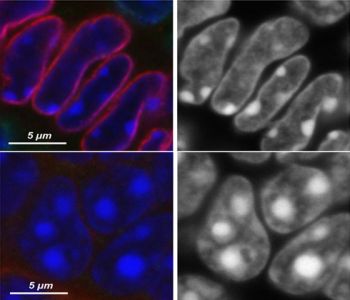|
| Friday, 8 February 2013, 11:30 HKT/SGT | |
| |  | |
Source: A*STAR | |
|
|
|
|
| Genes relocated from their correct position in the nucleus cause them to malfunction and this may lead to the heart, blood vessels and muscles breaking down. |
SINGAPORE, Feb 8, 2013 - (ACN Newswire) - Scientists from Singapore and Germany have identified that the proteins lamin A (Lmna) and lamin B receptor (Lbr) are essential for holding silent genes in their correct position at the edge of the nucleus, in the form of heterochromatin(1). A deviation from their normal position will cause the genes to malfunction, leading to heart failure, vascular disease and muscle wasting.
 | | A*STAR Scientists Make Groundbreaking Discovery of Cell Nucleus Structure Crucial to Understanding Diseases |
For hundreds of years before this discovery, scientists were puzzled by why heterochromatin clustered at the edge of the nucleus and how it was relevant to normal cell function. This recent discovery will enable scientists to gain a better understanding of the diseases of the heart and muscles, and find cures for them in the future.
The findings by Audrey Wang and Colin Stewart of A*STAR's Institute of Medical Biology and Irina Solovei, Boris Joffe and Heinrich Leonhardt of the Ludwig Maximillian University in Munich, Germany, were recently published in the prestigious journal Cell(2).
The nucleus - the brain of the cell - carries all the information, in the form of chromatin necessary to help a cell grow, thrive, and reproduce, in the form of DNA packed into chromatin. Hence, understanding how chromatin is organised in the nucleus is important to understanding disease and normal processes such as ageing. The scientists showed that the two proteins lamin A and lamin B receptor are important to the organisation of chromatin in the nucleus. Using mouse models, they demonstrated that in the absence of the two proteins, heterochromatin collapsed into the nuclear centre. This disrupted gene expression and affected skeletal muscle development, resulting in muscle failure.
Professor Stewart, Research and Assistant Director of IMB, said, "These findings will provide new insights into how diseases arise and may help explain how mutations in lamin proteins result in a variety of different syndromes. In particular, we are extending these findings to explore how changes in chromatin position may contribute to heart failure. Moving forward, we will collaborate with cardiologists and vascular clinicians at SGH and NUHS to translate these findings to benefit patients."
Professor Birgitte Lane, Executive Director of IMB, said, "I would like to congratulate Colin and the team for this important piece of research. It brings us a step closer to understanding the nucleus and to developing new treatments for common diseases. It could be particularly relevant for Singapore, as we, like other developed nations, are facing an ageing population, and heart failure, vascular disease and muscle wasting all increase with age."
Please see the full press release at http://bit.ly/VKC5pl .
(1) Chromatin is the combination of DNA and proteins that make up the contents of the nucleus of a cell. The structure of chromatin depends on the activity of the genes. Genes are either functional or silent depending on which cell type they are in. Silent genes tend to be packaged as heterochromatin whereas active, functional genes are in euchromatin.
(2) The research findings described in this news release can be found in Cell under the title "LBR and Lamin A/C Sequentially tether Peripheral Heterochromatin and Inversely Regulate Differentiation".
The research findings described in this news release can be found in Cell under the title "LBR and Lamin A/C Sequentially tether Peripheral Heterochromatin and Inversely Regulate Differentiation" by Irina Solovei [1], Audrey S. Wang [2],[3], Katharina Thanisch [1], Christine S. Schmidt [1], Stefan Krebs [4], Monika Zwerger [5], Tatiana V. Cohen [6], Didier Devys [7], Roland Foisner [8], Leo Peichi,[9] Harald Herrmann,[5] Helmut Blum,[4] Dieter Engelkamp,[10] Colin L. Stewart [2],[3],*, Heinrich Leonhardt [1],*, and Boris Joffe1,*. http://dx.doi.org/10.1016/j.cell.2013.01.009
[1] Department of Biology II, Center for Integrated Protein Science Munic (CIPSM), Ludwig-Maximilians University Munich
[2] Institute of Medical Biology, Singapore
[3] Department of Biological Sciences, National University of Singapore, Singapore
[4] Laboratory for Functional Genome Analysis (LAFUGA), Gene Center Munich, Ludwig-Maximilians University Munich
[5] Department of Molecular Genetics, B065, German Cancer Research Center (DKFC), Germany
[6] Children's National Medical Center, Center for Genetic Medicine, Washington
[7] Institute de Genetique et de Biologie Moleculaire et Cellulaire, France
[8] Max F. Perutz Laboratories, Medical University of Vienna, Austria
[9] Max Planck Institute for Brain Research, Germany
[10] Transgenic Service Facility, BTE, Franz-Penzoldt-Centre, Freidrich-Alexander-University of Erlangen-Nurnberg, Germany
*Correspondence: colin.stewart@imb.a-star.edu.sg (C.L.S.)
About the Institute of Medical Biology (IMB)
IMB is one of the Biomedical Sciences Institutes of the Agency for Science, Technology and Research (A*STAR). It was formed in 2007, the 7th and youngest of the BMRC Research Institutes, with a mission to study mechanisms of human disease in order to discover new and effective therapeutic strategies for improved quality of life. Since 2011, IMB also hosts the inter-research institute Skin Biology Cluster platform. IMB has 20 research teams of international excellence in stem cells, genetic diseases, cancer and skin and epithelial biology, and works closely with clinical collaborators to target the challenging interface between basic science and clinical medicine. Its growing portfolio of strategic research topics is targeted at translational research on the mechanisms of human diseases, with a cell-to-tissue emphasis that can help identify new therapeutic strategies for disease amelioration, cure and eradication. For more information about IMB, please visit www.imb.a-star.edu.sg.
Contact:
Ong Siok Ming (Ms)
Senior Officer, Corporate Communications
Agency for Science, Technology and Research
Tel: +65 6826 6254 (Office), +65 9733 7434 (Mobile)
Email: ong_siok_ming@a-star.edu.sg
Topic: Research and development
Source: A*STAR
Sectors: Science & Research
https://www.acnnewswire.com
From the Asia Corporate News Network
Copyright © 2026 ACN Newswire. All rights reserved. A division of Asia Corporate News Network.
|
|
|
|

|
|
|
|